The Dish @ Dashe
Fish Tales and Monkey Business from the Team at Dashe Cellars
 Mike Dashe Co-founder & Director of Winemaking
Mike Dashe Co-founder & Director of Winemaking
 Anne Dashe Co-founder
Anne Dashe Co-founder
 Rene Calderon Winemaker
Rene Calderon Winemaker
 Monica Chappell Wine Club Manager
Monica Chappell Wine Club Manager
Summer Chill'n
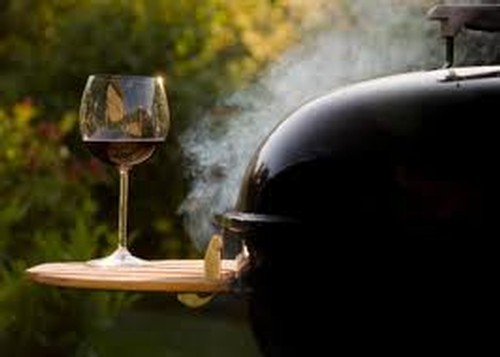
With summer in full swing, it's easy to find yourself pouring wine that is either too cold or too warm.
Just as the right glass will enhance your wine experience, serving artisanal wine at the ideal temperature is equally as important.
When it comes to knowing what temperature to serve a wine, you can follow this easy-to-remember tip: twenty minutes before serving, take the white wine out of the fridge, and put the red wine in. This rule is intended to fix the two most common mistakes in wine service—serving white wines too cold and red wines too warm.
Now, this is not something to lose sleep over, but the fact is that properly chilled artisanal wines do taste noticeably better.
Serving wine at its proper temperature enables you to taste wine at its full potential. Most of the enjoyment that comes from drinking artisanal wine involves its aroma. Taste only has four aspects: sweet, sour, salty, and acid. The nose does the rest. Vapors are created as artisanal wine warms up, so the wine needs to be a few degrees below its ideal drinking temperature for you to enjoy it at its finest. To be confident the wine you serve will be on its best behavior know the whole story.
Red Red Wine
If you've heard the old adage that red wines need to be served at "room temperature" don't forget that "room temperature" can be considerably higher in the summer. In fact, the adage that red wine should be served at room temperature was coined when people were storing and serving wine from their cellars, where wine was kept quite cool. Most artisanal red wines are at their best at cool room temperature, 62 to 65 degrees Fahrenheit. Light reds benefit from being served slightly cooler than full bodied reds. Keep reds too warm and they will taste alcoholic and even vinegary. Too cold and they will have an overly tannic bite and much less flavor.

Created in a lighter style and perfect for a slight chill, our 2018 Heart Arrow Ranch Zinfandel comes from an amazing biodynamic farm in Mendocino County. Biodynamic farming techniques, together with our old-world winemaking, create a broad range of aromas, flavors, and structure akin to a wine from Burgundy or Beaujolais. We ferment with native yeasts and age in a 900 gallon French oak barrel, resulting in a soft and elegant “Old-World” style wine.
Refreshing Whites
Just as many reds are served too warm, most white wines are served too cold. Artisanal white wines are best between 55 and 62 degrees. Chilling white wines properly preserve their freshness but too cold and they will be nearly tasteless. White wines served too warm will taste alcoholic and flabby.

Our 2019 Chenin Blanc “Concrete Cuvée,” Clarksburg was inspired by the Loire Valley wines the Dashe family enjoys every summer in France! Fermented in a large concrete egg, which suspends the lees for toasty overtones and preserves the wines delicate freshness and aromatics, this Chenin blanc is one of our most vivacious, textured, and seductive wines.
Bubbling Beauties
Sparkling wines should start out totally chilled and are best served between 40-45 degrees. Put them in the refrigerator an hour and half before serving or in an ice bucket with water for at least 20 minutes before serving. Artisanal sparkling wine will not stay at a constant temperature once it is out of the fridge so keep an ice bucket handy or put the bottle back in the refrigerator between pours.
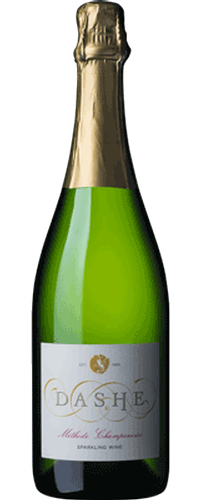
The vintage of 2016 marked the 20th anniversary of the founding of Dashe Cellars, and we felt that a sparkling wine was a perfect way to celebrate this occasion. We have long admired the beautiful sparkling wines made in the Loire Valley from the Chenin Blanc grape, and for this initial wine we used 100% Chenin Blanc from the Heringer Vineyard in Clarksburg, California.
You need not become a maniac with a thermometer to keep artisanal wine the right temperature range; a little experience and a little tasting, and the wine itself will tell you everything you need to know. So, chill this summer with a perfectly chilled glass of wine.
RECIPE ALERT! Comet paired with Pancetta Pot Pie
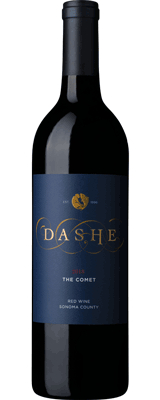
The perfect Zinfandel food pairing
The women in my family have a common addiction... we can sit around a kitchen table and flip through cookbooks for hours on end. Can you imagine how this was transformed for us when food blogging became popular? Over the years, I've discovered new favorite bloggers and explored new cuisines and pairings, specifically Zinfandel food pairing once I started working with Mike and Anne. But no matter how wide my internet roaming goes, I always come back to my favorite blog Smitten Kitchen. I've been making this pot pie recipe for years, and it's an amazing recipe. When paired with our 2018 'The Comet' though, it takes on an entirely new life. Please, before the spring comes, make this recipe & pop the cork on a bottle of Comet... You'll forget that spring training and summer sailing are still months away.
2018 'The Comet' Sonoma County
This wine is made of Petite Sirah and Zinfandel, blended with 130-year-old vine Carignane. The blend makes for a very complex, balanced, dark wine with a long, long finish. It’s a quintessential steak-house wine, made to go with food. It will last in the cellar for years!
Color: Reddish-purple
Aromas: Chocolate, black cherry, blackberry, followed by elements of toffee, vanilla, black pepper, and coffee
Taste: Extremely smooth and velvety entry, wine, with good acid balance, and silky tannins. The entry is of bright fruit—black cherry, blackberry, and pomegranate—and then a lush texture filled with fruit, cocoa powder, clove, and a spicy finish. The wine has a velvety mouthfeel and long finish.
Zinfandel food pairing: Asian 5 Spice Short Ribs, Grilled Venison with Berry Reduction, anything with Mole Poblano Sauce.
Click Here to buy the 2018 'The Comet' Sonoma County
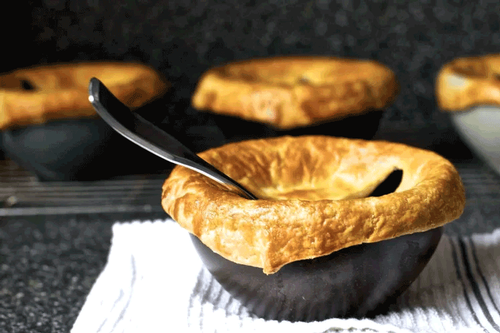
Pancetta, White Bean, and Chard Pot Pies
By Deb Perelman, from The Smitten Kitchen Cookbook - Zinfandel food pairing by Stephanie Flasher
The pancetta, while adding a lovely, smoky base, can be omitted to make this vegetarian. In fact, I went back and forth many, many times about removing it so that this could stay in the vegetarian section, but in the end, decided it easier I leave the choice to you. For a vegetarian version, simply skip the pancetta and cook your vegetables in 2 tablespoons olive oil instead of 1. You can replace the swiss chard with any green you have around, from a hearty spinach to kale, adjusting the cooking time accordingly to make sure it wilts a bit before going into the oven to finish cooking.
As you can see from the photos, I really don’t own soup crocks. I have debated the value of purchasing some many times of the years, but you must trust me when I say I don’t have room for a single extra dish I don’t already own in my life right now. Instead, I just use two-cup bowls we already have that are ovenproof. (When buying a dish set, I always look to see if they are ovenproof, as you never know when this will come in handy.) If you don’t have ovenproof soup bowls, you can always make a large version of this in a casserole dish with one big pastry .
Weekday night tip: Make a double batch of the stew and lids. Keep them separate and for two to three nights, you can ladle what you’d like into bowls, roll out lids and bake them to order.
Serves 4
Ingredients
Lid
- 2 cups (250 grams) all- purpose flour
- 1/2 teaspoon table salt
- 13 tablespoons (185 grams or 1 stick plus 5 tablespoons) cold unsalted butter, diced
- 6 tablespoons (90 grams) sour cream or whole Greek yogurt (i.e., a strained
- yogurt)
- 1 tablespoon (15 ml) white wine vinegar
- 1/4 cup (60 ml) ice water
- 1 egg, beaten with 1 tablespoon water, for egg wash
Filling
- 2 tablespoons (30 ml) olive oil
- 4 ounces (115 grams or 3/4 to 1 cup) 1/4-inch-diced pancetta
- 1 large or 2 small onions, finely chopped
- 1 large carrot, finely chopped
- 1 large stalk celery, finely chopped
- Pinch of red pepper flakes
- Salt and freshly ground black pepper
- 2 garlic cloves, minced
- Thinly sliced Swiss chard leaves from an 8- to 10-ounce (225- to 285-gram)
- bundle (4 cups); if leaves are very wide, you can halve them lengthwise
- 3 1/2 tablespoons (50 grams) butter
- 3 1/2 tablespoons (25 grams) all- purpose flour
- 3 1/2 cups (765 ml) sodium- free or low- sodium chicken or vegetable broth
- 2 cups white beans, cooked and drained, or from one and a third 15.5- ounce
- (440-gram) cans
Directions
Make lids:
In a large, wide bowl (preferably one that you can get your hands into), combine the fl our and salt. Add the butter and, using a pastry blender or your fingertips, cut them up and into the flour mixture until it resembles little pebbles. Keep breaking up the bits of butter until the texture is like uncooked couscous. In a small dish, whisk together the sour cream, vinegar, and water, and combine it with the butter-flour mixture. Using a flexible spatula, stir the wet and the dry together until a craggy dough forms. If needed, get your hands into the bowl to knead it a few times into one big ball. Pat it into a flattish ball, wrap it in plastic wrap, and chill it in the fridge for 1 hour or up to 2 days.
Make filling:
Heat 1 tablespoon olive oil over medium- high heat in a large, wide saucepan, and then add the pancetta. Brown the pancetta, turning it frequently, so that it colors and crisps on all sides; this takes about 10 minutes. Remove it with a slotted spoon, and drain it on paper towels before transferring to a medium bowl. Leave the heat on and the renderings in the pan. Add an additional tablespoon of olive oil if needed and heat it until it is shimmering. Add onions, carrot, celery, red pepper flakes, and a few pinches of salt, and cook over medium heat until the vegetables are softened and begin to take on color, about 7 to 8 minutes. Add the garlic, and cook for 1 minute more. Add the greens and cook until wilted, about 2 to 3 minutes. Season with the additional salt and freshly ground black pepper to taste. Transfer all of the cooked vegetables to the bowl with the pancetta, and set aside.
Make sauce:
Wipe out the large saucepan; don’t worry if any bits remain stuck to the bottom. Then melt the butter in the saucepan over medium- low heat. Add the flour, and stir with a whisk until combined. Continue cooking for 2 minutes, stirring the whole time, until it begins to take on a little color. Whisk in the broth, one ladleful at a time, mixing completely between additions. Once you’ve added one- third of the broth, you can begin to add the rest more quickly, two to three ladlefuls at a time; at this point you can scrape up any bits that were stuck to the bottom — they’ll add great flavor.
Note from Stephanie: to make this an even more perfect Zinfandel food pairing, sometimes I'll substitute a little broth for a splash of The Comet!
Once all of the broth is added, stirring the whole time, bring the mixture to a boil and reduce it to a simmer. Cook the sauce until it is thickened and gravylike, about 10 minutes. Season with salt and pepper. Stir the white beans and reserved vegetables into the sauce.
Preheat your oven to 375 degrees.
Assemble and cook pot pies:
Divide the filling between four ovenproof 2-cup bowls. (You’ll have about 1 1/2 cups filling in each.) Set the bowls on a baking pan. Divide the dough into four pieces, and roll it out into rounds that will cover your bowls with an overhang, or about 1 inch wider in diameter than your bowls. Whisk the egg wash and brush it lightly around the top rim of your bowls (to keep the lid glued on; nobody likes losing their lid!) and drape the pastry over each, pressing gently to adhere it. Brush the lids with egg wash, then cut decorative vents (smaller than mine, please, as they led to lots of draping) in each to help steam escape. Bake until crust is lightly bronzed and filling is bubbling, about 30 to 35 minutes.
Do ahead:
The dough, wrapped twice in plastic wrap and slipped into a freezer bag, will keep for up to 2 days in the fridge, and for a couple months in the freezer. The filling can be made up to a day in advance and stored in a covered container in the fridge.
Click Here to go to the original recipe posting on www.smittenkitchen.com
Enjoy!
If you haven't already, open up that bottle of 2018 'The Comet' and enjoy an absolutely stellar Zinfandel food pairing! I know what I'm going to be making tonight.
Say Cheese! The Right One Makes a Difference
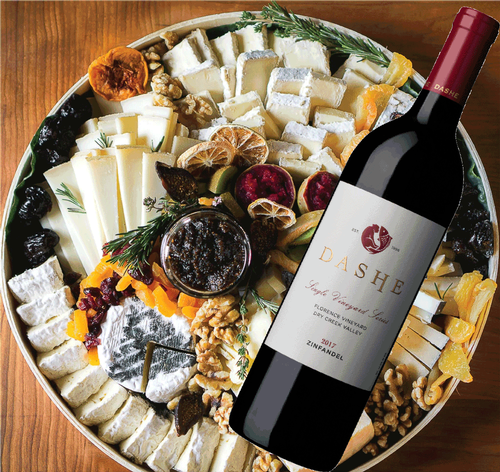
Perhaps one of my favorite things to pair with wine is the ever-changing cheese plate. Wine and cheese are friends from way back. Both are the product of fermentation and both can express terroir, or the taste of the place they come from. In the case of cheese, the taste of terroir emerges from the different milk-giving animals; which can range from cows, goats, sheep and even water buffalos which just happens to make my favorite cheese of all time – Mozzarella di Bufala.
This primer can serve as a perfect introduction to the basics and can offer many ways for you to expand your knowledge and understanding of artisan wine and cheese, delve into the art of pairing the two and help you discover a delicious new dimension to your wine-drinking pleasure. So Let’s Go!
Wine & Cheese Pairing Tips:
The first rule of thumb is that white wines usually pair more easily with artisan cheese than red wines do – sorry red wine lovers. White wine’s acidity cuts through cheese’s butterfat beautifully. The creamy and nutty flavors in cheese can also bring a white wine to life by contrast. Along those lines, some consider Sparkling wine the overall cheese-friendliest wine. Among red wines, the most successful to pair with cheese are the lighter bottlings. Terroir-inspired combinations, artisan wine and cheese coming from the same region, can also be a great pairing strategy.
Pairings that Please:
- White or bloomy rind cheeses such as Camembert and Brie are the trickiest to match; safe bets include one of Dashe’s soft, fruity reds from the Les Enfants Terribles Series. My pairing shortlist would include either the Bio-Dynamically grown Heart Arrow Ranch Zinfandel or the 2017 Clarksburg Grenache that was recently featured in Wine & Food Magazine.
Click Here for 2017 Zinfandel, Heart Arrow Ranch
Click Here for 2017 Grenache, Heringer Vineyard
- Hard cheeses such as Cheddar, Parmesan, and Manchego go with the widest range of wines; safe bets are medium to full-bodied reds without too much tannin. Insert an age-worthy artisan Zinfandel here – one of Dashe’s Single Vineyard Zinfandel would be just the ticket. For me, I’d unapologetically sink my teeth into the Florence Vineyard Zinfandel along with a hunk of Parmigiano- Reggiano.
Click Here for 2017 Zinfandel, Florence Vineyard
- Blue cheeses can be troublesome partners for any wine apart from the classic partnerships of port and Stilton. The salty with sweet principle prevails so why not try Dashe Late-Harvest Zinfandel from the Lily Hill Vineyard, Dry Creek Valley in Sonoma with your favorite blue veined cheese. My favorite blue is Point Reyes Original Blue also from Sonoma County – things that grow together go together.
Click Here for 2017 Late Harvest Zinfandel, Lily Hill Vineyard
- Strong, pungent cheese offers no safe bets. Sweet or fortified wines are likely to pair well or try an aromatic white such as the classic combination of Munster from Alsace and Riesling. Dashe Dry Riesling from McFadden Farm has a depth of flavor that makes it one of the most age-worthy Rieslings our artisan winery has ever produced, and it’s structured enough to stand up to strong cheeses.
Click Here for 2019 Dry Riesling, McFadden Farm
- For Goat milk cheeses, Sparkling wine is a good match especially with young soft artisan cheeses; the more acid in the cheese the more acid the wine should have. Along with crisp acidity, sparkling wine possesses wonderful bubbles to cleanse the palate. The 2016 marked the 20th Anniversary of Dashe Cellars and to commemorate we released Dashe 2016 Méthode Champenoise Sparkling wine.
Click Here for 2016 Sparkling Wine, Methode Champenoise
- Sheep milk cheese can handle a robust red made from Mourvedre, Carignane or Zinfandel. Hard to decide which direction to go in? Why not have it all with Dashe Ancient Vines Sonoma blend. Another option would be to go with one of two Dashe Single Vineyard Petite Sirah; Louvau or Todd Brothers Ranch, which is a wine club exclusive.
Click Here for 2017 'Ancient Vines', Sonoma County
Click Here for 2018 Petite Sirah, Louvau Vineyard
Click Here for 2018 Petite Sirah, Todd Brothers Ranch
Strategies for Harmony:
Cheese and wine is a classic pairing - like peanut butter and jelly or cookies and milk. Both are natural artisan products, created using a standard process but with a myriad of results. When planning a cheese platter, try upping the ante with roasted nuts, walnut bread and a selection of dried fruits to create a more wine-friendly match. When serving a selection of artisan cheeses, try to choose three or four which all pair well with a particular style of wine. Highly oaked and super-tannic wines can be difficult to pair with cheese so try avoiding these options.
Just say cheese please!
Opening Wine this Thanksgiving? Listen to this advice from a pro...
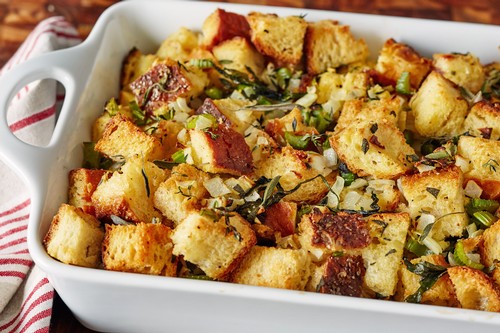
It’s that time of year when we dive headfirst into all things Thanksgiving – bring it on! Last year I hosted 25 people at our Thanksgiving table. This isn’t the year for relatives to travel, so with everyone celebrating the holidays with smaller groups and mostly immediate family this year, there will be smaller portions which means less leftovers! One thing that will not change is the effort put into the meal.
In my humble opinion, the ultimate Thanksgiving meal is about so much more than just the turkey and sides. If ever there were a wine lover's holiday, Thanksgiving would be it. And one of the pleasures of my Thanksgiving is that every family member has a role in the big meal. My role is a peach. I'm the wine gal. It's a fine job for a number of reasons with my favorite being the many tastings I conduct leading up to the final wine choice. It's a tough job, but someone has to do it. I usually receive family advice along the way; don't bring anything wildly expensive and don't bring anything too weird. To fit the bill, the wine needs to be a crowd-pleaser and match the weight of the menu. No problem. This year, with a cellar full of artisan wines from Dashe, I think I've got it covered.
I’ve got a few tips that I’ve learned over the years regarding planning the wine for this delicious yet tricky wine-pairing meal.
How Do You Choose the Right Wine?
Here's an easy answer: No single wine will work perfectly with your entire meal so serve a few. Regardless of which wine you choose the style to look for is medium-bodied, fruity, and without a lot of oak which might overpower the food.
How Much Wine Should You Buy?
A bottle is about five glasses, so I go with a bottle for every two people. If you are serving wine before dinner, add a glass more per person to the equation.
Which is it, Red or White?
Either! Hands down my most favorite part of Thanksgiving is the stuffing. No questions asked. Using the stuffing as a wine guide: if you serve a basic bread-and-celery version, try a white such as Dashe Les Enfants Terribles “Concrete Cuvée” Chenin Blanc or a dry Riesling such as Dashe McFadden Farm Potter Valley Riesling. Add hearty mushrooms or sausage to that basic stuffing recipe then one of Dashe’s signature reds such as the bio-dynamically grown Heart Arrow Ranch Zinfandel would be the choice. But the best rule is to let guests drink what they like; be it red or white so plan to have both on hand.
Click Here for our 2019 Chenin Blanc, Concrete Cuvée
Click Here for our 2019 Dry Riesling, McFadden Farm
Click Here for our 2017 Zinfandel, Heart Arrow Ranch
With all that is going on in the world, Thanksgiving is a good time for us to count our blessings. Whether you are cooking at home for your family or taking advantage of the amazing take-out options available, I hope this special meal provides some comfort during these challenging times.
Happy Thanksgiving!
Family Stuffing Recipe
By Monica Chappell
As I said earlier, stuffing and I are BFF’s. It is hands down my favorite part of the Thanksgiving meal and as a result, I’m sharing my family’s super-savory recipe so look no further. Trust me, this stuffing with lots of gravy drizzled on top, Heaven! So, without further ado here it is.
INGREDIENTS
- 1 medium onion chopped
- 1 cup celery chopped
- 2 tablespoons extra-virgin olive oil
- 1 tablespoon unsalted butter plus 2 tablespoons cubed
- 1/4 cup dry white wine – something you would drink!
- 1 pound sweet Italian sausage meat removed from casing
- 1/4 cup chopped Italian parsley
- 1/2 pound day old Ciabatta bread cut into 1/2-inch cubes
- Pinch red pepper flakes
- 2 eggs
- 1 cup chicken stock
- 1 cup freshly grated Parmesan cheese
PREPARATION
- Preheat oven to 400 degrees F.
- In a medium sauté pan add the onion, celery, 1 tablespoon oil and butter cook over a medium low heat for 10 minutes to soften. Add the wine and season with salt and pepper, simmer for about 5 minutes. Take off the heat and allow the mixture to cool.
- In a large sauté pan over medium high heat, add 1 tablespoon olive oil and Italian sausage meat and break up with a wooden spoon and cook until browned and cooked through, approximately 8 to 10 minutes.
- In a medium bowl toss together the celery and onion mixture, the chopped parsley, sausage, the Ciabatta bread and red pepper flakes. Combine all the ingredients.
- Whisk the eggs and add to the chicken stock, and 3/4 cup of the Parmesan. Gently place into an 8 1/2 by 8 1/2- inch glass Pyrex baking dish and top with the remaining Parmesan. Dot with butter. Place in middle rack and bake until top is golden brown, 45 minutes to 1 hour.
How to Organize your Wine
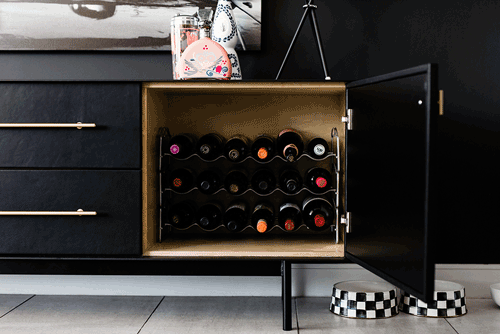
Whether you have 15 or 500 bottles, organizing your wine has a wide range of benefits. You can save precious time trying to find a bottle when you’re hosting a party and your guests are ready for some more, or be able to find the optimal pair for your food easily because you know exactly what you have. When I’m not working in our Tasting Room, I have my own business as a Professional Organizer and I have helped quite a few wine-loving clients create systems for their collections. Here are some of my top tips and tricks.
Traditional ways to organize your wines:
- By vintage a.k.a year the grapes were harvested, which helps if you are a fan of aging.
- By varietal a.k.a grape type, like Chenin Blanc or Zinfandel.
- By region a.k.a the location the grapes come from, like Napa or Bordeaux.
- By producer a.k.a label or maker, like Dashe Cellars or Ridge Vineyards.
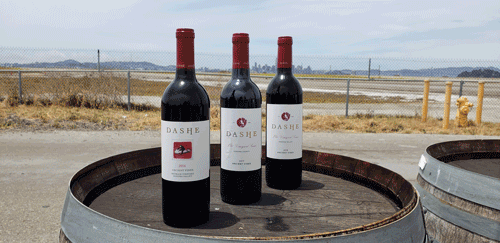
Another option is to organize your wines by your drinking style:
Foodie:
If you think about wine with food in mind, you can organize your wine in terms of bottles that are food friendly and those that are more for easy drinking regardless of food. You can further break down the food friendly section by body, which can help you choose a pair depending on your meal’s protein or cuisine type.
Collector:
If you are someone who has the patience to age wine or someone who fancies vertical wine tastings (tasting the same wine but different vintages side-by-side), you can separate your wines by bottles that are ready to drink now and bottles that you are laying down with the intent to enjoy them in the future.
Social:
If you love to be the host with the most, you can organize your wine by party size or type. You may have a section of more inexpensive wines for the larger, party vibe and a section of wines more suited to the more intimate gathering atmosphere.
Or, you can keep it super simple with three sections:
Dive on in:
Bottles you can grab whenever for whatever. You or your guests can go to town in this section and find whatever floats your boat.
Do think twice:
A little more thought goes into this middle section which might include wines that were gifts or are geared more towards food pairing.
Don’t touch:
Bottles with very special meaning or very special price points that you are saving for very specific reasons or occasions.
Take it a step further by...
- Using a metallic sharpie or paint pen to write the drink by date or the memory of where you got the wine on the back or bottom of the bottle
- Labeling the rows or sections in your collection. This is a great way to avoid potential arguments (and possible tears) over the accidental opening of a special wine.
- Make sure your collection is earthquake safe! Keep the more expensive bottles at the bottom so they are less likely to fall over.
RECIPE ALERT! Pozole Verde paired with 2017 Grenache
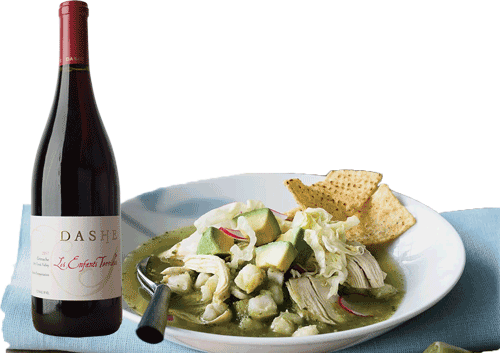
We have quite the collection of gourmands here at Dashe Cellars. Monica, with her Italian heritage, can throw a pasta feed for 60 at the drop of a hat. Mike will spend the day making the perfect Bolognese for his homemade lasagna (don't tell my mom, but it's the absolutely best that I've ever tasted). And if you haven't tasted Anne's baking then you haven't lived, seriously I'm always impressed when we have a team lunch and Anne shows up first-thing in the morning with an amazing dessert fresh from the oven.
Food-Pairing Reds
So, when we decided to host a lunch for Anne for her birthday, I knew that I had to not only find a recipe that would impress, but I needed to find the perfect wine to match. Lucky for me, our 'les enfants terribles' wines are the perfect wines for pairing with lighter-bodied dishes like this Chicken Pozole that I found on Food & Wine's website. These wines tend to be lighter and more ethereal in style than our more structured single-vineyard wines. This is because of a style of fermentation known as Carbonic Maceration in which the grapes are fermented intact rather than being pressed when they come in from the vineyard. We age them for a short amount of time in large 120- or 900-gallon oak casks which keep the fruit fresh and without too much oak influence.
2017 'les enfants terribles' Grenache
A beautiful wine that offers bright, lively fruit with a great structure and balance. This Grenache is made in almost a Grand Cru Beaujolais style that offers a velvety texture with aromas of wild strawberry and flavors of strawberries and raspberries and a finish of minerals and peppery spice.
Color: Pale Red
Aromas: Wild strawberry, pomegranate, spice, minerals
Taste: Beautiful velvety texture. Entry of intense strawberry, raspberry, and pomegranate fruit. Beautiful floral elements of lavender and violets, long, sweet finish of red fruit, minerals and peppery spice.
Click Here to buy the 2017 Grenache
Mexican Chicken Verde
By Anya Von Bremzen Food & Wine Issue May 2008
Makes 6-8 servings
There are many variations on pozole, a traditional hominy-based Mexican stew closely associated with the Pacific-coast state of Guerrero. Anya von Bremzen's version, a green pozole, derives much of its flavor from tangy ingredients like tomatillos, cilantro and green chiles.
Ingredients
- 7 cups chicken stock or low-sodium broth
- 2 cups water
- 4 chicken breast halves on the bone, with skin
- 1 pound tomatillos, husked and halved
- 1 small onion, quartered
- 2 poblano chiles—cored, seeded and quartered
- 2 jalapeños, seeded and quartered
- 4 large garlic cloves, smashed
- 1/2 cup chopped cilantro
- 1 tablespoon oregano leaves
- Salt and freshly ground black pepper
- 1 tablespoon vegetable oil
- Three 15-ounce cans of hominy, drained
- Finely shredded iceberg lettuce, sliced radishes, chopped onion, diced avocado, sour cream, tortilla chips and lime wedges, for serving
How to Make It
Step 1
In a large, enameled cast-iron casserole, bring the chicken stock and water to a boil. Add the chicken breasts, skin side down, cover and simmer over very low heat until they're tender and cooked through, about 25 minutes. Transfer the chicken breasts to a plate and shred the meat; discard the bones and skin. Skim any fat from the cooking liquid and reserve.
Step 2
In a blender, combine the halved tomatillos with the quartered onion, poblanos and jalapeños, smashed garlic, chopped cilantro and oregano. Pulse until coarsely chopped, scraping down the side. With the machine on, add 1 cup of the cooking liquid and puree until smooth. Season the tomatillo puree with salt and pepper.
Step 3
In a large deep skillet, heat the vegetable oil until shimmering. Add the tomatillo puree and cook over moderate heat, stirring occasionally, until the sauce turns a deep green, about 12 minutes.
Step 4
Pour the green sauce into the cooking liquid in the casserole. Add the hominy and bring to a simmer over moderate heat. Add the shredded chicken to the stew, season with salt and pepper and cook just until heated through. Serve the pozole in deep bowls, passing the lettuce, radishes, onion, avocado, sour cream, tortilla chips and lime wedges at the table.
Click Here to go to original recipe posting on www.foodandwine.com.
Top 5 Secrets of Cooking with Wine
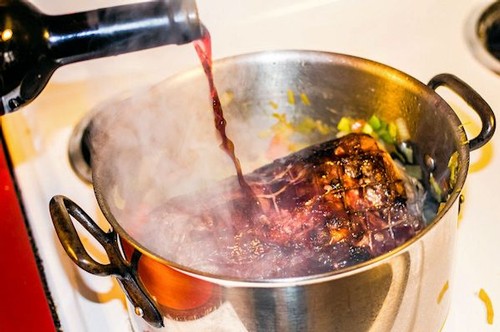
There's no better way to spend a SIP evening than creating a delicious dish while sipping a Dashe wine for inspiration. When the topic of food and wine pairing comes up, the usual flow of conversation revolves around what wine to drink WITH dinner. Yet sometimes the tougher decision is what wine to put IN dinner. That's because when listed as an ingredient, wine is often suggested in the most generic terms, and you're left to wonder - will any wine do? But there is more to cooking with wine than using up last night's leftovers. Take a look at my top 5 tips.
Leftover Wine
As a general rule, never cook with any wine you would not drink. The month old leftovers in the refrigerator won’t do. Any off flavors in wine become more concentrated during cooking.
Cooking Wine
Avoid using these all together. They are made of a thin, cheap base wine to which salt and food coloring have been added.
White Wine
If the dish has bold or spicy flavors go for a more aromatic white such as our Dashe McFadden Farm Dry Riesling made from organically grown grapes from the Potter Valley. Our newly released 2019 vintage has a wonderful fruit/acid balance along with floral aromas that can counterbalance heavily spiced dishes.
Click Here for our 2019 Dry Riesling, McFadden Farm
Dry Red Wine
If a recipe calls for dry red wine, consider the heartiness of the dish. A long-simmered meat dish calls for a correspondingly hearty red like a Cab. A lighter dish might call for a less powerful red such as one of our lighter-styled 'les enfant terribles' Zin’s.
Click Here for our 2016 Cabernet Sauvignon, Heart Arrow Ranch
Click Here for our line of 2017 'les enfant terribles' Wild Children
Sparkling Wine
When you cook sparkling wine, you eliminate its primary qualities, bubbles, and alcohol. However, a simple beurre blanc sauce can benefit from the two remaining qualities of a good sparkler: high acidity and yeast flavor.
Click Here for our 2016 Sparkling Wine, Methode Champenoise
Happy Cooking!
Keeping Quarantine Delicious
Baking Bread, Making Wine, and Pairing Cheese
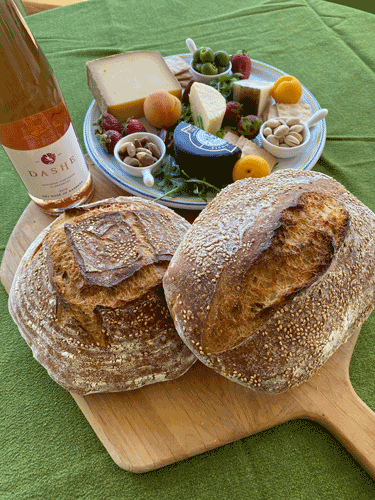
When my kids were unceremoniously kicked out of university and the entire family was bunkered at home, I decided it was time to step up as a fermentation scientist and get to work: fermenting sourdough starter; figuring out the best wines to match with fresh-baked levain bread; and pairing it all with the perfect cheese (a necessity with a French wife and kids).
After all, the best way to keep everyone happy when in close quarters is to keep everyone well-fed and focused on a task that would take everyone’s talents to succeed. My wife is also a winemaker and a hell of a baker, so she would be natural help (although half the time she acted more like a Greek chorus than a French baker). My daughters were brought up as both French and American, so I figured that they would throw themselves into the project simply because they love good food. Not insignificantly, I also figured that baking my own levain bread was going to save me a bundle of money. A good loaf of bread in San Francisco costs a small fortune, so baking my own bread for $0.50 of per loaf was going to be a perfect way to economize while simultaneously creating something we all could enjoy.
The First Step: Natural Yeast or Not?
The winemaking was already taken care of, and the cheese selection would be the last step, so baking the bread was by far the most time-consuming part of the process. It took only a few minutes to decide to make bread with natural yeast starter rather than buying commercial dried active yeast. As someone who has lived in San Francisco since the early ‘80s, I already had an affinity for sourdough bread as a daily staple. Having a warm loaf of sourdough, and then matching it with a freshly steamed-and-cracked crab (with melted butter) and a salad is just about as perfect a meal as there is in my book. There are dozens of great bakeries in the Bay Area that supply bread to the local stores, so our family had already zeroed in on levain—a bread made with wild yeast—as one of our favorite styles of bread.
The first issue was that I hadn’t ever made sourdough bread, much less created a wild sourdough starter. But as a winemaker, I felt that fermentation was going to be the least of my problems, because if anyone could detect a fermentation going wrong, it was going to be me.
Full-disclosure, I cheated at the start, because rather than create my own starter from scratch I decided to get a bit of actively fermenting sourdough starter from friends. It’s a time-honored way to get one’s starter, and it has the advantage that you know from the start what kind of bread the starter can produce. One call to a couple that I knew made great bread, and they were happy to give me a half-cup of starter.
Start with a Good Starter
If there’s anything I learned during this whole process that I could offer as a tip is: get a good, strong, actively fermenting starter. A good starter is the heart and soul of a good levain bread, and it is the one ingredient that requires a bit of work and understanding. For one thing, it is messy. And sticky. And it smells…yeasty. The aroma is not bad at all—in fact, it smells a bit like a very toasty champagne if the champagne was left out overnight—but it is not everyone’s cup of tea. But even if you find the tangy aromas of your starter off-putting, it only requires that you fold it into your dough, because the eventual bread itself has only a slight hint, a whiff, of the tanginess of the starter.
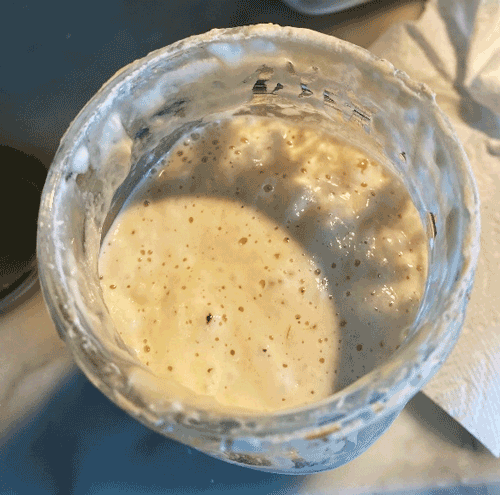
Just a word to the wise: if you need to get a starter and you live in an urban environment, like San Francisco, there are many bakeries out there that will just give you starter if you simply ask them. It is not as if you need a lot of starter, because you only need a half cup or less of starter to commence.
Once you have located a source of starter, the fun has just begun. Once you’ve obtained the starter, you must cultivate it and coax it to be the best starter that it can be. And there is only one way to do that—by feeding it, like it is a living being. Regularly. Every morning and every night. It’s like a pet that doesn’t have the decency to respond to you. Feeding it is not so hard (it is actually just a few spoonfuls of flour and a bit of water), but it’s got to be done regularly if your starter is going to be active and create a semi-decent loaf of bread. You wake up in the morning, say hello to your starter, dump most of it out, and then give the remaining half cup or so some flour and water. By the afternoon, it has doubled or tripled in size (like a man-eating plant in Little Shop of Horrors) and is ready to be used.
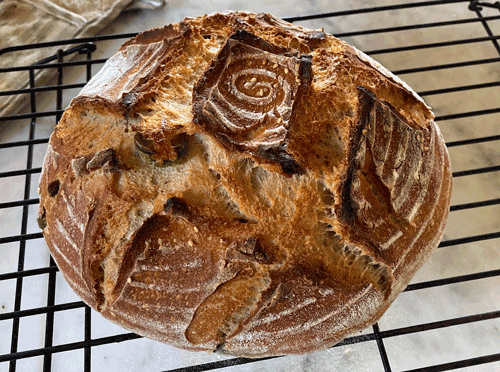
The Zen of Baking: If You Aren’t Patient, You’re Screwed
As a winemaker nothing gets me as worked up as a good fermentation, and although wine still captures the prize for heart-racing full-tank fermentation, a good sourdough starter and bread-making marathon comes in a close second. To start out making bread for the first time, I heartily recommend the YouTube video “15 Mistakes most Beginner Sourdough Bakers Make” from ProHomeCooks—I followed the instructions to the letter and came out with a more than decent result.
I must confess, it takes patience to make levain. Realistically, it’s a day and a half process. I’ve now made bread five or six times, and the only time that the results were less than ideal (i.e. the shape and density of a Frisbee) was when I tried to shorten the process by not giving it the necessary time to rise.
So, take a breath and prepare to make yourself useful while you wait. I won’t go into every step of making the bread (that’s what YouTube videos are for!), but I will let you know a couple of things that I learned in the process.
- First of all, make sure that your starter is as active as possible, and has risen three-fold or more at the time you use it. It should have lots of bubbles on the surface and smell tangy.
- Second, don’t get impatient during the bulk rise step, when you are waiting for your dough to rise before putting it into its final shape. I made the mistake of trying to shorten this step, assuming that the bread would rise as much as it needed during it’s second rise (the “proofing”), but sadly, it didn’t.
- Last, make sure you have a decent Dutch Oven (Le Crueset is the best) to bake your bread. It creates a little steam oven to bake the bread and creates a great crust.
- As extra credit, it helps to get a spiral basket—called a “banneton”—for the final proofing of the dough. It creates the spiral effect that gives the bread a professional look.
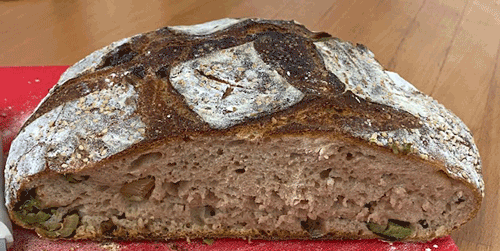
You’ve Baked your Bread, Now Select the Wine
There’s nothing quite as gratifying as slicing into one of your loaves—your creation—and seeing a bread that rivals the best you’ve bought in a bakery. It has a great crust, and the crumb of the bread (the interior structure) is light and airy.
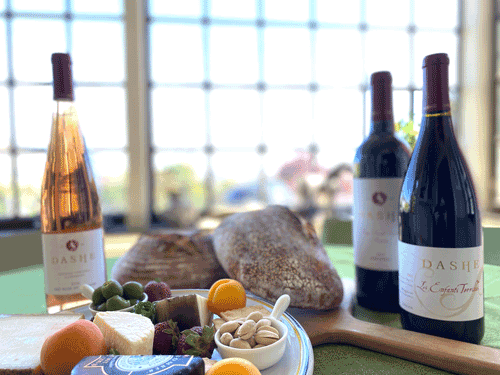
Now, the question is: what wine to pair with the bread? It’s been hot lately, so I’m always partial to rosé this time of year. Personally, I think that rosé goes with almost anything when it’s hot outside, and it goes so well with salad, cheese, and bread that it’s a natural choice.
Click Here for our 2019 Rosé of Barbera, Heringer Vineyard
One of the best aspects of a levain bread is that the subtle nuttiness and tanginess of the bread goes perfectly with a range of wines, especially when you put cheese selections into the mix. In the summertime, I prefer light reds, so Cabernet Franc, Grenache, or Gamays all do well. As a winemaker that specializes in Zinfandels, I would be remiss if I didn’t suggest a lighter Zinfandel style such as our Les Enfants Terribles Mendocino Cuvee, our biodynamic Heart Arrow Ranch Zinfandel, or our Dry Creek Reserve Zinfandel.
Click Here for our 2017 Zinfandel Reserve, Dry Creek Valley
Don’t Forget the Cheese!
My wife and kids provided much of the enthusiasm for creating the bread, trying to keep things into perspective when I was certain that the bread wasn’t rising correctly, etc. They also were the first people in line to slice a piece of warm bread (please, let it rest an hour out of the oven before cutting, so that the texture of the bread isn’t moist and gummy) when the bread comes out of the oven.
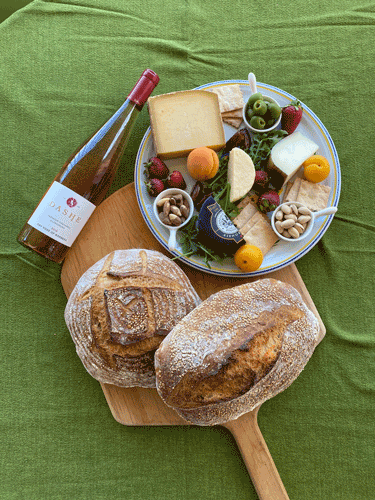
Any French family loves to eat their bread with fresh butter—and definitely salted butter if you’re from Brittany, and salted butter with crystals that crunch if you’re actually IN Brittany). Cut some slices of a nice Comté or Gruyere cheese, or maybe a sheep cheese such as Petite Basque or a Spanish Manchego to go with it, and now you’re talking some serious hedonistic pleasure. We even used a fine English white cheddar and some fruit, to pull everything together.
Combine that with a view of the San Francisco skyline, and the current problems seem much more manageable.

